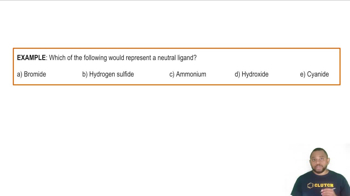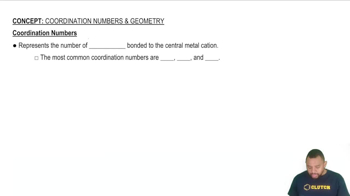Ch.23 - Transition Metals and Coordination Chemistry

Brown15th EditionChemistry: The Central ScienceISBN: 9780137542970Not the one you use?Change textbook
Chapter 23, Problem 27
Complete the exercises below. For each of the following molecules or polyatomic ions, draw the Lewis structure and indicate if it can act as a monodentate ligand, a bidentate ligand, or is unlikely to act as a ligand at all: a. ethylamine, CH₃CH₂NH₂, b. trimethylphosphine, P(CH₃)₃.
 Verified step by step guidance
Verified step by step guidance1
Step 1: Draw the Lewis structure for ethylamine (CH₃CH₂NH₂). Start by identifying the central atoms and arranging the hydrogen, carbon, and nitrogen atoms accordingly. Connect the atoms with single bonds, ensuring that each hydrogen atom is bonded to a carbon or nitrogen atom.
Step 2: Complete the octet for each atom in ethylamine. Carbon atoms should have four bonds, nitrogen should have three bonds and a lone pair, and hydrogen should have one bond.
Step 3: Analyze the Lewis structure of ethylamine to determine its ability to act as a ligand. Consider the presence of lone pairs on the nitrogen atom, which can donate electrons to a metal center, making ethylamine a potential monodentate ligand.
Step 4: Draw the Lewis structure for trimethylphosphine (P(CH₃)₃). Identify phosphorus as the central atom and arrange the three methyl groups (CH₃) around it. Connect each methyl group to the phosphorus atom with a single bond.
Step 5: Evaluate the Lewis structure of trimethylphosphine to determine its ligand properties. Check for lone pairs on the phosphorus atom, which can donate electrons to a metal center, indicating that trimethylphosphine can act as a monodentate ligand.
Key Concepts
Here are the essential concepts you must grasp in order to answer the question correctly.
Lewis Structures
Lewis structures are diagrams that represent the bonding between atoms in a molecule and the lone pairs of electrons that may exist. They help visualize the arrangement of electrons and the connectivity of atoms, which is crucial for understanding molecular geometry and reactivity. Drawing Lewis structures involves determining the total number of valence electrons and distributing them to satisfy the octet rule for each atom.
Recommended video:
Guided course

Lewis Dot Structures: Ions
Ligands
Ligands are ions or molecules that can donate a pair of electrons to a central metal atom to form a coordination complex. They can be classified as monodentate, which bind through a single atom, or bidentate, which can attach through two atoms. Understanding the nature of ligands is essential for predicting the behavior of coordination compounds in various chemical reactions.
Recommended video:
Guided course

Ligands Example
Coordination Number
The coordination number refers to the number of ligand donor atoms that are bonded to a central metal atom in a coordination complex. This concept is important for determining the geometry of the complex and its stability. For example, a metal with a coordination number of 2 typically forms linear complexes, while a coordination number of 4 can lead to tetrahedral or square planar geometries.
Recommended video:
Guided course

Coordination Numbers
Related Practice
